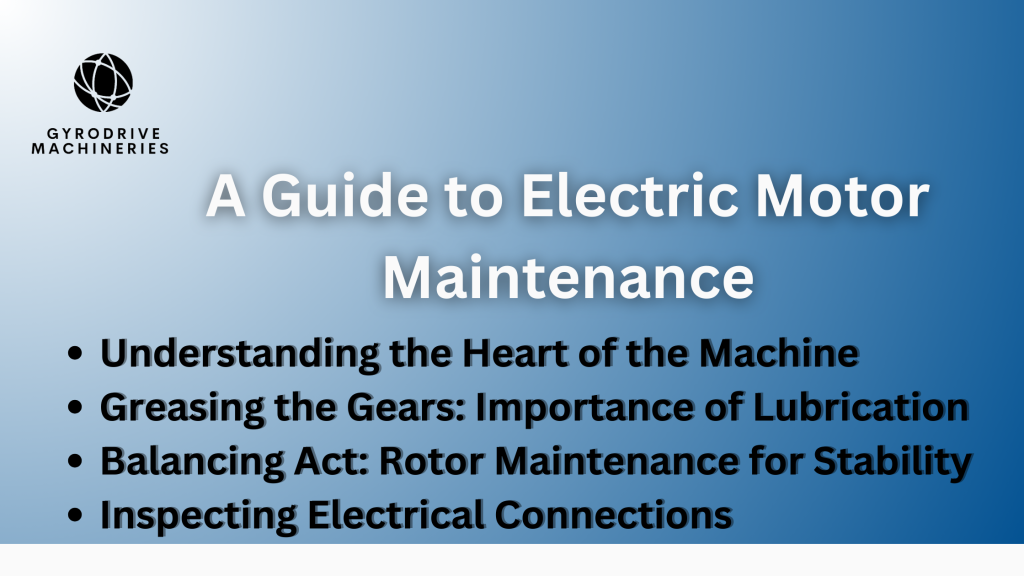Unlocking Peak Performance: A Guide to Electric Motor Maintenance
In the realm of machinery, electric motors play a vital role, powering everything from industrial equipment to household appliances. Maintaining the heartbeat of electric power – the electric motor – demands precision and care. At Gyrodrive Machineries Private Limited, a forefront player in product development and motor design, the commitment to excellence extends to the meticulous upkeep of their creations. Electric motors maintenance is like giving your car a regular oil change – it keeps everything running smoothly and extends the life of the engine. In this article, we delve into the intricate world of electric motor maintenance, uncovering the secrets that keep these mechanical marvels humming with efficiency.
Understanding the Heart of the Machine
Imagine an electric motor as the heart of a mechanical system, pulsating energy to keep the entire apparatus alive. Regular maintenance is akin to a health check-up for this heart, preventing potential issues and ensuring optimal performance. Within the motor’s housing, various components work in harmony, converting electrical energy into mechanical motion. Bearings, windings, and the rotor are the unsung heroes, and their well-being is crucial for the motor’s longevity.
Greasing the Gears: Importance of Lubrication
Just as joints need lubrication to move smoothly, bearings in an electric motor demand the same care. Lubricating these components is a fundamental yet often overlooked aspect of maintenance. The right grease creates a protective layer, reducing friction and heat generated during operation. Regular checks and re-greasing, ideally every six months, keep the bearings in top-notch condition, ensuring a seamless rotation that minimizes wear and tear.
Balancing Act: Rotor Maintenance for Stability
The rotor, the rotating part of the motor, is a heavyweight champion that requires balance for optimal performance. Over time, imbalances can occur, leading to vibrations and potential damage. Precision is the key when it comes to rotor maintenance. Dynamic balancing, a process that redistributes weight evenly, prevents these vibrations and enhances the motor’s efficiency. Regular checks on the rotor’s balance, especially after significant operational hours, are a proactive measure to avoid performance disruptions.
Cracking the Code: Inspecting Electrical Connections
In the intricate dance between electrical and mechanical components, connections are the choreography. Faulty connections can disrupt this dance, causing inefficiencies and even system failures. Periodic inspections of electrical connections are crucial, ensuring they remain tight and free of corrosion. Loose connections generate heat, which is the enemy of electric motors. Tightening bolts and cleaning terminals are simple yet effective measures to safeguard against potential electrical maladies.
Temperature Tales: Cooling System Maintenance
Electric motors, like any hardworking engine, generate heat during operation. To prevent overheating, these machines are equipped with cooling systems, typically in the form of fans. Ensuring the cooling system operates at peak efficiency is paramount for motor health. Regular cleaning of fans and ensuring proper ventilation around the motor prevent heat buildup. Additionally, monitoring the motor’s temperature during operation provides valuable insights into its well-being, allowing for timely intervention if temperatures rise beyond the norm.
Precautions to be taken during electric motor maintenance inspections
- Only delegate electric motor repair work to people who are experienced with electrical components. Those who conduct this task must be aware of potentially harmful conditions.
- Qualified people performing maintenance inspections should wear protective clothing, as well as dielectric tested gloves and appropriate electrical test devices.
- Employees must verify that pulleys and belts are properly aligned and that operational parts move freely and without excessive friction. Contactors and relays can be checked for binding and sticking parts by hand.
- Employees should be encouraged to do routine maintenance tasks that keep their surroundings dust-free and clean in order to avoid generating an undesirable path for electric current to flow.
Conclusion: Empowering Tomorrow’s Motors Today
Electric motor maintenance is the unsung hero of the industrial and technological landscape. Regular attention to bearings, rotor balance, electrical connections, and cooling systems is akin to providing a nurturing environment for these workhorses. In doing so, we not only enhance their lifespan but also ensure they operate at peak efficiency, contributing to the smooth functioning of the machinery they power. So, whether you’re overseeing a manufacturing plant or maintaining your home appliances, remember: a well-maintained electric motor is the lifeblood of industry and innovation.


Leave a Reply